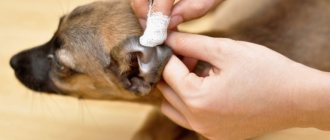Redness of the skin in dogs.
The skin is the most important organ, since it is it that protects tissues and internal organs from damage, foreign objects, sudden temperature changes and even dehydration. In addition to its protective functions, the skin performs a number of tasks, such as, for example, the synthesis of vitamins. Moreover, this organ is responsible for the perception of sensations from the outside world.
Thus, any tissue damage, inflammation and redness that occurs on the dermis indicate serious disturbances in the functioning of the body. The danger of such unfavorable changes is that any redness on the dog’s skin is quite difficult to detect, since the animal’s epidermis is usually protected by a dense layer of hair. However, it is not difficult to notice redness in some areas, for example on the stomach. If such a symptom is detected, pet owners should immediately sound the alarm, since redness is usually a clinical sign of a number of diseases.
Possible causes of redness on the skin in dogs
As mentioned above, redness of a dog’s skin may indicate dangerous diseases, including:
- Allergy, the manifestation of which can also be dermatitis. Virtually anything can trigger an allergic reaction. Such factors include certain foods, drug ingredients, pollen, mold, and even anti-parasitic collars. Inflammation and redness of the skin are often caused not by the allergy itself, but by the behavior of the animal - the dog may scratch the skin due to severe allergic itching. Other clinical signs that usually accompany an inadequate response of the body to an irritating substance include the appearance of swelling, thin nasal discharge, frequent sneezing and profuse lacrimation. To alleviate the dog’s condition and improve its quality of life, the owner must try to identify the allergen and minimize its effect on the pet’s body. If the allergy has become very serious, the animal may require drug treatment.
- Parasitic infestation. Fleas, ticks and lice on your dog's skin can also cause severe redness. It can be triggered either by an allergic reaction to the saliva of arthropods or by the dog’s self-scratching.
- Seborrhea, also known as dandruff. This condition is characterized by severe peeling of the epidermis and the subsequent appearance of light-colored scales. Most often, the occurrence of seborrhea is directly related to serious disturbances in the formation of dermal cells. In addition to redness of the skin, the presence of this disease is indicated by a strong unpleasant odor emanating from the animal. Seborrhea is extremely difficult to cure, but you can fight it with the help of special cosmetics for dogs.
- Various infections that can enter the animal’s blood through mechanical tissue damage. Bacteria that multiply rapidly at the site of a wound or scratch can cause swelling, redness and inflammation of the skin. Typically, such symptoms are observed within a few days and go away on their own or with the support of certain antiseptic disinfectants. But if this does not happen, animal owners should definitely contact a veterinarian.
- Infectious diseases such as pyoderma, caused by staphylococci.
- Ringworm is an infectious disease caused by a skin fungus. At an early stage of the disease, the animal develops round bald spots. In the center of these formations there are usually remnants of wool. If the disease has time to develop, the spots begin to peel off greatly, and the skin on them becomes noticeably red. Subsequently, a crust may form on the bald spots. Treatment should begin immediately, as lichen can be transmitted through personal contact with an infected animal.
- Tumors. Small bumps may appear all over your dog's body. A solitary, slow-growing mass is most likely a benign tumor. Removing swelling will help get rid of them once and for all. Malignant tumors, on the contrary, are very dangerous for a dog’s health. These formations can appear completely suddenly and grow very quickly. You can notice them by their reddish tint.
- Hypothyroidism. This disease occurs when there is a large deficiency of the hormone secreted by the thyroid gland. This tendency leads to a slowdown in metabolism and, as a result, to rapid weight gain, noticeable lethargy and apathy of the dog. In this case, the animal can freeze very much even at normal temperatures. With hypothyroidism, severe bald spots and dandruff become noticeable on the body of a dog with hypothyroidism, and the dermis itself can become very flaky and red. Diagnosis of the disease is possible only in a veterinary clinic. The treatment itself involves the use of a number of hormonal drugs prescribed by a doctor.
- Cushing's syndrome. This disease causes disruption of the adrenal glands and causes severe hair loss in the groin, sides, neck and back. Additional clinical signs of Cushing's syndrome are increased thirst and appetite in the dog. It is quite expected that along with an increase in the amount of fluid consumed, the frequency of urination significantly increases. An additional danger of the disease is that it weakens the immune system and indirectly contributes to the development of various infections.
- Pemphigus. This is an autoimmune disease in which cells begin to attack their own tissues as if they were foreign. Pemphigus is characterized by the appearance of multiple ulcers throughout the body, as well as swelling and redness of the skin in general.
Treating skin redness as a separate factor simply does not make sense. Such a change in the color of the dermis is, first of all, a symptom that can only be eliminated if the cause of its occurrence is eliminated. That is why, upon discovering redness on the animal’s skin, owners should immediately contact a veterinarian.
Symptoms of skin diseases in dogs with descriptions and photos, treatment.
Today, skin diseases in dogs are increasingly being diagnosed. The main provoking factor is environmental degradation. But some pathologies are inherited by animals.
Treatment
In order to alleviate the dog’s condition, treatment must be carried out from the first days. There are methods that you can apply at home yourself, and there are remedies that are recommended after consultation with a veterinarian.
Therapeutic methods
First of all, veterinarians recommend focusing efforts on reducing itching on the skin, since scratching helps spread wounds throughout the body, in addition, this can provoke the addition of fungal flora to the affected areas. For this, antihistamines are prescribed.
Often, veterinary treatment involves the use of apricot kernel oil, licorice or buckthorn decoctions. All these products should be applied to the skin of a sick dog in areas of lesions of pityriasis rosea. It is important to prevent the development of staphylococci, streptococci and other microbes that are very difficult to treat.
If it is not possible to prevent a fungal infection, then antibiotics are prescribed that suppress pathogenic microflora. To reduce peeling and dryness of the skin, apply zinc ointment. The inflammatory process is controlled with anti-inflammatory corticosteroids.
Sometimes salicylic acid is recommended in solution, the concentration of which is chosen by the veterinarian based on the condition of the skin. Salicylic acid not only has an antibacterial effect, but also accelerates healing processes.
If the affected area is large, ultraviolet irradiation may be prescribed. It is performed only with the help of special equipment that allows you to dose and accurately direct ultraviolet rays.
Home methods
Treatment with home methods can give good results and lead to the disappearance of symptoms. One of the proven medicines is sea buckthorn oil. Use a cotton swab soaked in this product to moisten the lesions three times a day. At the same time, you don’t have to worry about the dog licking the oil, since it is completely harmless to pets.
Another method is based on washing the lesions with apple cider vinegar 7 times a day. It is strictly prohibited to use ordinary table vinegar for these purposes, since its concentration is higher than that of apple vinegar, which can cause burns on the dog’s skin.
Equally as effective is celandine tincture, which is easily prepared at home. The crushed celandine is placed in a dark glass jar and the whole thing is filled with vodka. After 21 days the tincture is ready. It should be given to the dog orally, preferably after breakfast, 10 drops at a time. If you cannot get the dog to swallow the infusion, you can wash the stains with a moistened cotton swab.
Skin diseases in dogs
The largest organ of a dog's body is the skin. This is a powerful barrier that stops the penetration of dangerous microorganisms into the body. As a unique thermostat and natural “air conditioner,” skin has a number of important functions.
Based on its condition, the owner can determine whether the pet is healthy or sick. The following factors have a negative effect on the skin:
- Hormonal imbalance.
- Hypovitaminosis.
- Cardiac pathologies.
- Unbalanced diet.
An unbalanced diet can cause skin diseases.
Types of skin pathologies
The following types of skin diseases are distinguished:
A parasitic type of skin disease in dogs.
Parasitic pathologies
To kill the tick, you will need to trim the dog's fur.
Most often, diseases such as demodicosis and sarcoptic mange are detected in animals. These pathologies are characterized by severe course and long-term treatment.
Demodectic mange was formerly called "red scabies". Its beginning is quite specific. First, small dry spots appear on the animal’s paws and head. They itch very much and the pet scratches them until they bleed.
Demodectic mange is dangerous because the mite spreads through the lymph system and spleen.
Often the mite is encapsulated in the roots of the fur. To destroy it, the animal is shorn. This provides medications with access to all layers of the skin. With timely treatment, you can get rid of parasites in 2–3 weeks.
The mites that cause sarcoptic mange bite into the dog’s skin, digging “tunnels” in it. Their life cycle is 20 days. They are very difficult to detect.
Diagnostics
With sarcoptic mange, the dog's hair begins to fall out.
To clarify the diagnosis, the veterinarian first takes a scraping from the affected area. Most often, ticks live on:
The main symptom of sarcoptic mange is active hair loss. The skin darkens, folds form on it, and dandruff appears. The affected areas are very itchy, which leads to scratching.
Sarcoptic mange is treated with medication. In some cases, the disease is transmitted to the owner. Parts of the body that come into contact with the dog begin to itch painfully.
Fungal pathologies
Microsporia is a fungal infection.
Microsporia is usually diagnosed in dogs. This pathology is caused by the fungus Microsporum canis. Identifying the disease is quite simple. The veterinarian places the dog under an ultraviolet lamp. The fungus living on the skin is highlighted in a greenish color. If the need arises, the sick animal is sent for laboratory examination.
Many fungal pathologies are dangerous to humans.
Treatment and diagnosis
The room in which the dog lives should be disinfected.
After clarifying the diagnosis, the veterinarian prescribes drug therapy. Taking medications is combined with baths. And products are also used for local treatment of affected areas of the skin.
Long-haired dogs are cut. In order to prevent relapse, the room in which the pet lives is thoroughly disinfected. Bedding and toys need to be replaced.
Bacterial pathologies
The most common bacterial pathology is pyoderma.
Pyoderma in a dog.
The dog's skin is completely “occupied” by microorganisms that quickly penetrate deep inside. The disease is provoked by staphylococcus or streptococcus. Affected areas are found near the anus and on the thighs.
If the disease is not treated, the infection spreads to:
Symptoms and treatment
Symptoms may occur in puppies. You need to sound the alarm when specific black dots appear.
The disease is long and difficult to treat. The dog is prescribed antibiotics. Drug therapy is accompanied by bathing and treating the skin with antiseptic drugs.
For treatment, the dog should take antibiotics.
Neglected bacterial pathologies contribute to the development of abscesses. Anemia may result.
Allergic pathologies
Allergy refers to the reaction of antibodies that are present in a dog’s body to irritants. The result of this is histamine activity. Reacting with blood particles, it provokes the development of the inflammatory process.
Chemicals can act as an allergen.
An allergic reaction is caused by:
The most dangerous medications are considered to be the penicillin group.
Often the allergic reaction is immediate. It can also appear 2-3 hours or several days after contact with the irritant.
Eczema in a dog
A common cause of localized baldness on the skin in dogs is eczema. The disease is the most difficult to treat. Has a weeping character and is dry.
You should not treat eczema on your own. Laboratory tests are required. Before receiving them, local treatment of the pet’s skin begins. For dry eczema, it is possible to use moisturizing ointments with antibiotics and regenerating agents. The hair around the spot needs to be trimmed. You can lubricate the spots with ointment to relieve pain and itching. However, this is not a treatment, but only the elimination of individual symptoms.
Only a doctor can prescribe complete treatment after examining the pet and passing tests. The dog needs to increase its overall immunity and nutritious nutrition.
If your dog has ulcers on his lips, it is better not to wait until they transform into huge sores. Some owners ignore their appearance, arguing that everything will go away on its own, but this is always the case. Yes, there are many cases where the cause lies in harmless snags or injuries after playing, but subcutaneous mites and fungal diseases cannot be ruled out. Here you cannot do without a visit to the veterinarian. But even here there may be problems, since not all veterinarians can distinguish demodicosis from acne.
Other skin diseases in dogs
Other skin pathologies include: dermatophytosis, pitarospora, ectoparasites.
Dermatophytosis is otherwise called lichen.
- Dermatophytosis is also called lichen. When a pet becomes infected, bald patches form on its skin. They do not cause the animal much concern. There is no redness, no burning or itching.
- Pitarosporosis is usually located on the lower jaw. Sometimes it spreads to the ears and lips. A specific sign of this pathology is the release of mucus from the affected areas.
- Ectoparasites are grass mites, lice, and fleas. They cause the animal severe suffering. But today it is much easier to get rid of ectoparasites than to cure many skin pathologies.
Clinical picture
Symptoms are divided into 3 groups:
Skin diseases in dogs are accompanied by itching.
The skin usually itches constantly and very strongly. The dog is suffering, cannot sleep, is anxious, and is spinning around on its mat. As a result of scratching, hair falls out and wounds form. Sometimes the animal bites its paws or the base of its tail.
Blisters, warts, or plaques may appear on the skin. The size of the new growths varies from a few millimeters to 1–1.5 cm. Their shade can be pinkish or burgundy. The plaques peel off and itch even more.
If the affected area becomes infected, inflammation develops. The skin swells greatly. Sometimes suppuration appears.
Treatment at home
- Aloe juice is a good remedy for many skin diseases. Applied to the affected areas, it relieves the animal from painful itching, burning and other discomfort. The juice of this plant can be purchased at a pharmacy, or you can prepare it yourself.
- Medicinal chamomile has a similar effect. It should be used for bathing. The medicine stops microbial suppuration on the skin and quickly relieves inflammation. Chamomile can be alternated with echinacea and calendula.
Aloe juice is good for skin diseases.
Folk remedies can be used only when the disease is in its initial stage. If the pathology is advanced, it can only be treated in a veterinary clinic.
Dietary recommendations
Royal Canin is on the allergen list.
Many owners feed their dogs incorrectly. Proponents of “natural food” often thoughtlessly give animals everything they eat themselves. Another part of the owners treats their pets with cheap dry food. This leads to a lack of zinc and essential fatty acids. Sometimes painful symptoms appear due to excess calcium.
The development of skin pathologies is often caused by the consumption of premium food.
Royal Canin is considered the most allergenic food. It is recommended to replace it with such super premium products as:
Natural food dog menu
If the owner is a supporter of natural nutrition, then he must know that the animal’s diet should consist of 50–70% meat, 25–30% dairy products, 15% vegetables, and 20% cereals.
Meat is one of the main foods for dogs.
The ideal menu for a dog is a combination of lean meat and dairy products. Vegetables, buckwheat, rice, barley are additions to the diet. Meat can be replaced with fish.
About traditional methods of treating pityriasis rosea
As we have already said, treatment at home can give good results. You can use the following natural remedies:
- The affected areas are lubricated daily with sea buckthorn oil. The frequency of treatments is three times a day.
- The same thing, but with apple cider vinegar - treat seven times a day.
An excellent remedy is celandine tincture, which you can easily prepare yourself. To do this, you need to take a dark glass jar or bottle, which is filled with crushed leaves and stems of celandine. All this is poured with the required volume of vodka or diluted alcohol and infused for 21 days. Subsequently, the dog is given this infusion along with food, 10 drops per day. If this cannot be done, the tincture is used to lubricate the inflamed areas twice a day. It is also recommended to wash these areas with a decoction of buckwheat. To make it, you need to take two tablespoons per liter of water and boil the composition over medium heat for an hour.
Using these simple methods, you can quickly make your pet's life easier and improve its quality.
Preventive recommendations
The animal must be regularly treated with anti-parasite products.
- If your pet has been in contact with stray or sick animals, you must thoroughly bathe it using special shampoo or soap. Then you need to disinfect his place, bowls and toys. It would not be superfluous to take the animal for a preventive examination to a veterinary clinic.
- A reasonable preventive solution is timely vaccination. If your pet regularly participates in exhibitions, it needs to be vaccinated from time to time.
- If the animal does become infected, it is necessary to isolate it from other pets and family members. All clothing will need to be washed with a disinfectant and thoroughly boiled.
If the dog has been in contact with a sick animal, it should be thoroughly bathed.
Diagnostics
Determining an accurate diagnosis is necessary to prescribe adequate treatment. When visiting a veterinary clinic, a medical history and clinical examination are required. In addition, a number of laboratory and instrumental studies are prescribed. Next, the dog is scanned in a dark room using a special device - a lamp with ultraviolet radiation. The affected areas of the skin will glow with a specific light under the rays.
If lichen is suspected, the veterinarian should take scrapings from the lesions and examine them in more detail using a microscope. An important role in diagnosing pink spots in a dog is played by bacterial microflora culture. Establishing an accurate diagnosis includes serological tests, if necessary, as well as allergy tests.
Video about skin diseases in dogs
We determine allergies in our dogs.
Allergies in dogs are not as rare as we might imagine. Pets are a lot like people: they know how to be happy, play and even laugh. However, they are also susceptible to all kinds of diseases and disorders, one of which is an allergic reaction. The symptoms are quite individual, although among them, depending on the nature of the infectious agent, we can distinguish those that are most clearly manifested in dogs of all breeds, without taking into account individual characteristics.
Possible causes of a pink spot in a dog
In veterinary medicine, there are a number of diseases and systemic disorders in the body that manifest themselves as pink spots on the skin. The main ones are:
- Acute dermatitis with a weeping base. The disease is diagnosed quite often not only in dogs, but also in other warm-blooded animals. The cause of weeping dermatitis in the overwhelming majority is injury to the dog, complicated by pathogenic bacterial microflora. The spots formed on the skin are quite voluminous, formed individually. As a result of the development of pathology, the hair on the affected areas of the skin falls out, and the pet experiences severe pain.
- Dermatophytoses. Unites a whole group of ailments caused by fungal microorganisms. Fungi that infect the skin also disrupt the structure of the hair follicle, which leads to areas of baldness. As a rule, dermatophytoses appear on the animal’s face or neck, less often covering areas of the body. The development of the disease occurs gradually and is initially characterized only by the appearance of pink spots on the skin. As the pathology spreads, the animal begins to feel severe discomfort, itching, and as a result of severe scratching, the areas become inflamed, causing the development of the disease in other parts of the body.
- Ringworm. A characteristic sign of the development of lichen is a pink spot that appears on the dog’s stomach. Depending on the type of lichen, the location of the spots and symptoms will vary. Thus, ring-shaped lichen covers the entire body of the pet, and scales appear on the spots, causing itching in the animal. Ringworm in an animal can be caused by a fungal or infectious nature. For example, pityriasis rosea and herpes zoster are caused by viral agents. Pityriasis and ringworm develop as a result of the proliferation of fungal microorganisms on the skin.
- Allergic type reaction. Pink spots on the lip or other parts of the body that are not heavily covered with hair may be evidence of allergic reactions. The reasons for the manifestation of allergies in the form of spots on the body lie in the body’s specific reaction to foreign protein components. By eliminating the cause of the allergy, all manifestations, including those on the skin, can be completely eliminated.
- Demodecosis. Subcutaneous mites are the cause of the development of a rather dangerous disease. Red scabies (another name for the disease) is characterized by the appearance of spots on the skin localized in the area of the hind and forelimbs. Pink and subsequently red spots require treatment under the supervision of a qualified veterinarian.
The most common cause of pink spots is lichen. Infection occurs when a pet comes into close contact with the fur of a sick animal, soil (infected with fungal microorganisms or viruses), as well as when the animal’s hygiene rules are violated.
There are a number of factors that create favorable conditions for the development and infection of a pet:
- young and elderly animals;
- weakened immune system;
- eating disorders;
- malignant neoplasms;
- the period of bearing and feeding puppies.
Types of allergies
So, allergies happen:
- Food (accordingly, its causative agent is the food consumed);
- Medicinal (reaction to antibiotics, tablets, drops, etc.);
- Exposure to cosmetics or other dog grooming products;
- Infectious (caused by third-party organisms);
- Reaction to insect bites or other parasites;
- Autoimmune (very rare);
- Rest.
A common symptom of all types of allergic reactions in dogs is itching, inflammation and redness of the skin. It is not always possible to notice this, since the skin is hidden by fur. That is why it is necessary to regularly examine the animal.
Signs of food allergies
- Hair loss – hair is lost not evenly throughout the body, but in patches. As a result, so-called bald spots are formed, which, without receiving proper treatment, begin to progress: to grow. However, hair loss does not always indicate an allergy; it can also be a symptom of more serious diseases. Such, for example, as: folliculitis and hypothyroidism.
- Itching - the dog itches intensely and very often (as already mentioned, it is impossible to determine the presence of an allergy, much less its type, by this sign alone).
- Redness – under the fur, the skin has a pronounced pink or red tint.
- Dandruff is definitely an allergic sign. The skin is literally strewn with white particles (dandruff). Although this may also indicate dermatitis.
- Excessive dryness and roughness of the skin.
- The unpleasant body odor is slightly sweetish, not so noticeable at first, but as the allergy progresses it becomes more intense and pungent, almost unbearable.
- Sweat – The chest and armpit areas sweat. Sweat, like the previous symptom, becomes more pronounced over time. In special cases, wet spots remain on the surface. Sweating is generally not typical for dogs; it is a sign of an unhealthy process in the body.
- Often the dog begins to shake his ears and scratch them, the ears become filled with a dark substance and become inflamed. Erect ears droop. This is a sign of otitis media, which in most cases is a consequence of food allergies.
- Tears - the dog’s eyes are constantly wet or white (sometimes brown or yellowish) lumps form in their corners (this may also indicate entropy).
- The smell from the mouth is unpleasant, often putrefactive. In addition, the dog's lips and gums sometimes become covered with ulcers, boils, or are simply inflamed.
- Symptoms found in small numbers indicate the chronic nature of the allergy. The animal must be shown to a veterinarian immediately.
Ignoring problems can lead to serious, so-called secondary consequences as a result of scratching and biting the skin.
Dermatitis (caused by fleas)
The most common allergy. Its manifestation is not distinguished by any special symptoms: the dog itches, its skin is inflamed and has a reddish tint, and subsequently so-called papules form. They are localized mainly in the groin and sacrum areas. After a long period of time, the skin becomes drier and “overgrown” with white dandruff. This reaction is caused by a special substance contained in the saliva of fleas.
Allergic contact dermatitis
Also one of the most common types of allergic reactions. The main difference between its symptoms and the signs of other diseases is the localization of inflammation, itching and pustules strictly in areas devoid of fur. Namely:
- Stomach;
- Groin area (scrotum);
- Feet;
- Chin.
Atopic dermatitis
According to veterinary statistics, it is the second most common disease in dogs.
It has no characteristic features: it is also accompanied by itching, inflammation, redness, ulcers, hardened crusts, etc. However, a similar phenomenon is observed mainly in dogs aged from six months to three years. The first area to be affected (again, only according to observations, not with 100% probability) is the ear area. After which inflammation begins on the face, paws, groin and axillary areas. A common sign is the dog’s constant and nervous licking of the listed places.
Staphylococcal dermatitis
An extremely rare form of allergy to bacteria produced by the body’s own body can be either an independent disease or a consequence of some form of dermatitis. It is accompanied by redness and quite severe itching, but over time, purulent wounds form on the skin in the area of the tail, groin and sub-pectoral area. The extreme stage is boils, ulcers, enlarged lymph nodes. Everyone is individual, so manifestations may vary slightly.
Urticaria – drug allergy or reaction to stings
An uncommon occurrence. Red swollen areas appear. Two main and very characteristic features are localization on the muzzle and smooth, precisely defined edges of redness. The rash disappears after literally a day, but after a while it returns and disappears again. Thus, urticaria permanently torments the animal, but the owner may simply not notice it.
Otitis in dogs
The following types of otitis media are distinguished:
- Allergic;
- Caused by untreated disease.
It affects the ear areas, both external and internal. Identifying a sore ear is quite simple: the dog often tilts its head in its direction. Otitis is accompanied by the following symptoms:
- Warm or hot ears;
- The dog constantly shakes its head or scratches the skin near its ears;
- When pressure is applied to the base of the ear, the animal begins to worry and (in advanced forms) feels pain, whines and breaks out;
- The inside of the ears is inflamed and has a bright red (sometimes pink) color;
- If left untreated for a long time, mucus, white, clear or brown, begins to come out of the ears. Sometimes the discharge is purulent;
- Decreased appetite;
- Lack of activity;
- High body temperature;
- General lethargy.
According to research by experts, dogs with large and “droopy” ears are most often susceptible to otitis media. Those animals whose ears are small, standing or cropped do not have such reactions.
Other accompanying symptoms
- Signs that do not clearly characterize any allergy, other than itching and redness, include diarrhea. It can be either a reaction to a food allergy or a consequence of an advanced state of another type of allergy.
- Sometimes there is a frequency of stool, but it is not necessarily liquid.
- The gums become bluish or gray.
However, to obtain an objective picture, these signs must be considered only in conjunction with others.
Consequences
If the manifestation of an allergic reaction in humans is limited, as a rule, to a runny nose, sneezing or small rashes on the skin, then in dogs this process occurs somewhat differently. The skin itching in animals is much stronger, it is almost impossible to notice it in time. A dog, scratching the affected areas, cannot control its own strength and sometimes causes itself not only damage to the outer covering, but also more serious injuries.
In the absence of at least a little treatment, the disease progresses rapidly, not only causing inconvenience and physical pain, but also affecting more and more new areas of the body, of which the groin area and muzzle are the most vulnerable.
On a number of sites devoted to this topic, you can read information about the relative safety of allergic reactions and how to eliminate them on your own. To think this way is to harm your own pet. Indeed, some signs of allergy are invisible to the owners and pass without a trace: the dog itches for some time, after which its body eliminates the causative agent of the infection. However, these are only positive cases.
Perhaps one of the most terrible consequences is allergic anaphylactic shock. The dog's breathing becomes difficult and can develop into suffocation, which often leads to death in the absence of emergency help.
As already mentioned, it is necessary to regularly carry out at least a superficial examination of the pet: part the fur, look at the ears, check the condition of the mucous membranes. Such simple and painless measures will help identify allergies in its primary stages. However, it must be remembered that the manifestation of any general or single symptom cannot correctly and unambiguously indicate the type of allergy, on the definition of which further treatment will depend. In addition, dog allergy symptoms usually vary from person to person. Therefore, the owner’s first action after detecting a symptom is a trip to the veterinarian.
Is it possible to cure dog seizures on your own?
Seizures in the corners of a dog’s mouth manifest themselves as inflammation of the skin and mucous membrane of the lips. The scientific name of this disease is cheilitis. In dogs, these lesions cause pain and discomfort. The animal can rub against the ground and objects, comb out the scabs with its paws.
The causes may be different, and to select the optimal treatment regimen it is necessary to accurately determine the main factor that gave rise to this disease. Because in some cases, cheilitis is a symptom of other complex diseases, often of a systemic nature.
Cheilitis: external signs, types, causes
In veterinary medicine, seizures in dogs or cheilitis refer to the field of dentistry, which is responsible for the healthy condition of the oral cavity or mouth of the animal as a whole.
Externally, this disease can be determined by the appearance of the following signs:
- scabs or dead pieces of whitish skin at the junctions of the edge of the lip and the skin, which gradually peel off and open weeping, painful wounds;
- nodular dense formations on the hair follicle, when opened, pus is released;
- inflammation of wrinkles and folded areas of the skin of the lower lip at the point of contact with the upper fangs;
- weeping wounds in the folds of the jowls and lips.
Depending on the causes and external form of manifestation, cheilitis is divided into four types:
- Catarrhal. Differences: uniform inflammation of the lips, redness, peeling of the epithelium. Reason: mechanical damage to the lips and mucous membrane: injuries, cuts, punctures, scratches, bites, chemical exposure: accidental contact with hazardous substances.
- Glandular. Differences: extensive swelling of the internal mucous membrane of the labial glands, discharge of purulent secretion with the subsequent formation of thickenings and bumps, unpleasant odor from the mouth. Cause: trauma, as a starting mechanism, from dental damage or external mechanical influences, fungal and viral infections, as a consequence.
- Eczematous. Differences: inflammation and redness of the lips, peeling, thickening in the form of ulcers, weeping tears in the outer crust. Reason: allergic reactions to medications, food products against the background of vitamin deficiency in B-vitamins.
- Fungal. Differences: there is a white film coating on the lips with bleeding at the tears, dry lips and, as a result, the dog constantly licks them, pain when opening the mouth. Reason: fungal infections, seizures manifest themselves as a secondary disease against the background of oral dysbiosis, a general decrease in immunity, lack of A and B vitamins, digestive disorders and carbohydrate metabolism, other inflammations of the oral cavity, and overdose of medications.
Observations show that snags most often appear in dogs with sagging jowls, the accidental damage of which is more likely. Another risk group is representatives of hunting breeds: spaniels, setters, greyhounds, which in the process of chasing injure the mucous membrane of the lips with branches and grasses.
Common Oral Diseases in Dogs
Food absorption in dogs is different from this procedure in humans. Four-legged animals do not chew their food, but swallow it in pieces. Therefore, diseases such as caries are rare, but problems with periodontal tissue (periodontal tissue), on the contrary, are common. Pets experience the following problems that cause inflammation in the mouth:
- Cheilitis is inflammation of the lips.
- Gingivitis - the mucous membrane of the gums suffers.
- Stomatitis - oral mucosa.
- Tartar - formation occurs due to the mineralization of dental plaque.
- Caries - hard tooth tissues are destroyed.
- Pulpitis - the pulp of the tooth becomes inflamed.
- Periodontitis - affects the tissue around the teeth.
- Periodontitis (periodontal disease) is damage to the periodontium and bone tissue.
- Stomatitis in dogs - the mucous membrane of the mouth becomes inflamed. It has obvious signs: it is painful for the animal to eat, salivation is noticeable and an unpleasant odor may appear from the mouth. If you examine the mouth, you will see swelling.
To alleviate the condition, you can irrigate the mucous membrane with a warm, light solution of table salt. You can also use the well-known potassium permanganate, making a pale pink solution. Always have baking soda on hand. Dissolve 0.5 tsp. in a glass of warm water. A two percent solution of protargol is also suitable. Or treat the mucous membrane with Lugol's solution. You can use medicinal herbs: chamomile, sage, oak bark.
Gingivitis
– with this disease, inflamed gums in dogs are observed. The gums acquire a bright red color and become swollen. You may notice difficulty eating and drooling. Sometimes the gums bleed. There are catarrhal, ulcerative and hypertrophic forms of gingivitis.
Periodontitis in dogs
. The tissues called periodontal tissue become inflamed. Subsequently, the periodontal tissue is destroyed, and the bone tissue of the alveolar cavity of the jaws (the hole in which the tooth root is located) suffers.
Symptoms are similar to the gingivitis described above. After a thorough examination of the oral cavity, you can see pockets in the periodontal zone. Teeth hurt and become loose. In advanced cases, tooth loss is possible.
Treatment should be carried out by a veterinarian. You need to approach the situation comprehensively, taking into account all aspects.
Periodontal disease in dogs
— periodontal damage occurs due to the pathological condition of the tissues. They become loose, metabolism is disrupted. It lasts for a long time, usually chronically. Periodontal disease appears as a consequence of somatic diseases. As the disease worsens, you may notice pale gums and exposed tooth roots. The spaces between the teeth increase, which in the later stages become mobile.
Treatment is prescribed only by a specialist after a thorough examination of the oral cavity.
Dog oral hygiene
The main thing is for the animal owner to remember that proper care and prevention of the animal’s mouth allows you to avoid many diseases and increase the effectiveness of treatment procedures. How to brush your dog’s teeth, how often you should brush your dog’s teeth and how to brush your dog’s teeth, read the article here
To prevent the development of unpleasant symptoms, it is necessary to pay attention to the oral cavity: regularly examine, brush the dog’s teeth twice a week with specialized pastes, remove stones, and carry out immunization on time. Such simple procedures can maintain an excellent quality of life for your pet!
Treatment and prevention
After examination and laboratory tests of epithelial particles carried out to establish an accurate diagnosis, the dog is prescribed a course of treatment. Depending on the type of cheilitis, medications of various groups are used.
For eczematous - antihistamines: suprastin, diphenhydramine, tavegil, as well as ointments based on corticosteroids: sinalar, prednisolone.
For fungal infections, use antifungal agents: nystatin, levorin, the oral cavity is washed with antiseptic solutions: chlorhexedine, miramistin.
For any type of seizure, it is recommended to lubricate the mucous membrane 2-3 times a day with a mixture of glycerin and borax in a ratio of 20:5 and treat it with a 3% solution of baking soda. To strengthen the general condition of the animal, complexes of multivitamins and minerals, as well as immunostimulants, are prescribed. The duration of treatment depends on the stage of development of the disease and accompanying symptoms.
Prevention of seizures will include regular examinations of the dog’s oral cavity, good nutrition, physical activity, and prevention of accidental injury. This is something that a dog owner must do all the time. If you find wounds, inflammation, peeling and other signs of jamming in your pet’s mouth, you must visit a veterinary clinic for an examination and consultation to avoid the risk of spreading the infection.
Thus, seizures on a dog’s lips can occur primarily due to allergies, injuries followed by infection, viral and fungal infections. But this manifestation can also indicate other, hidden diseases. Accurate diagnosis in a veterinary clinic will guarantee the correct treatment.
What should you do if your dog's fur turns red or pink?
Owners of both white and dark dogs face such a problem as reddening of the coat. However, it is strictly forbidden to ignore such a manifestation, since it may indicate that your pet has serious health problems.
Possible diseases
If your dog has a very swollen lip and there are accompanying symptoms such as itching, tearing, ulcers or redness, then the following pathologies should be excluded:
Allergy
The most common cause of swelling of the face and limbs in animals. A reaction can develop to improperly selected food (often observed in decorative breeds prone to various types of dermatitis) or close contact with an allergen (drugs, substances or plants).
Food allergies always manifest themselves acutely, accompanied by swelling near the eyes, swelling of the upper or lower lip, tearing and severe itching. As the process progresses, weeping areas may appear. This reaction is common in English and French bulldogs to sweets or grapes (it is generally contraindicated for all breeds, as it is very toxic to dogs).
Contact dermatitis is more common in spring and summer. If your pet has access to wildflowers, plants and weeds, then there is a high risk of developing an allergic reaction to the pollen and flowering of some of them.
A distinctive feature is the lightning-fast development of symptoms . The nose, area around the eyes and lips swell. The eyes begin to water and sour. In smooth-haired breeds, you can see a clear reddening of the folds on the face (pugs, bulldogs).
Food allergies require increased attention, since it is necessary to exclude the component that provokes the reaction from the diet, select a diet and hypoallergenic food. For contact dermatitis, antihistamines are indicated (stop itching, Tavegil, Suprastin). It should be remembered that it is not possible to cure contact allergies once and for all; it can only be taken under control for the entire period of the animal’s life.
Insect bites
The most common cause of severe lip swelling in dogs. This is especially true for young individuals who have not had time to become acquainted with wasps or bees.
Unfortunately, such bites carry a threat of suffocation due to swelling of the larynx, and therefore require immediate response from the owner. You can tell that your pet has been bitten in the face by the way it thrashes around and rubs the affected area.
Having carefully examined this place, you can find that it is hard and swollen with obvious redness. Depending on the weight of the animal, the required dose of Tavegil or Suprastin is selected. And even after taking antihistamines, it is recommended to visit a veterinarian.
Neoplasms
They are not often found on the lips, but if they appear, they bring a lot of trouble. A papilloma, histiocytoma, sarcoma, or squamous cell skin cancer may appear on the lip. Only papilloma is characterized by its large size and rapid growth. The remaining formations grow slowly, starting with small nodules.
Malignant neoplasms often ulcerate and bleed . The nature of the formation can only be determined using a biopsy and cytological examination. In any case, surgical excision of the formation followed by histology is required. If malignancy is confirmed, chemotherapy may be used.
Why does this happen in white animals?
You can identify the reasons for changes in hair color in a pet through a detailed examination of the animal. If the fur is red all over the body, it is impossible to determine the cause of such changes on your own; you should definitely contact a veterinarian.
If redness of the fur is present in certain parts of the body, then in this case, you can identify the cause of this manifestation yourself.
On the chest and stomach
Changes in the color of the hair in the chest and abdomen are possible due to its constant wetting, which is especially typical for animals living on the street or in the yard. In this case, redness of the fur can be caused by simple exposure to the sun - it has faded.
Also, the hair on the chest and abdomen may turn red and pink as a result of any allergic reaction (to plants, food). As a rule, allergies are also characterized by changes in the pigmentation of the skin, and an unpleasant sweetish odor emanates from the pet.
Near the eyes
If the hair turns red or pink in the eye area, this may indicate the presence of an allergic reaction to the food (in some cases, tearing from the eyes is also observed).
Around the mouth and on the paws
But much more often, a change in hair color is observed in the area of the paws and “beard”.
The presented areas of the body constantly interact with moisture, as a result of which a fungus forms on them, which causes the hair to turn red and pink.
The presence of fungus can be detected due to the presence of specific odors in the affected areas.
To prevent the development of fungus, you need to constantly wipe your dog’s paws after washing them, keep your pet’s bedding dry, and control the air humidity in the room where the dog spends most of the time.
Also, dogs with white fur are characterized by redness due to the presence of:
- demodicosis (bacterial inflammation of hair follicles);
- problems with the functioning of the digestive organs;
- hormonal imbalances.
The most common reason for color change is the presence of old fur that did not fall out during molting. In such a situation, the pinkish hair is localized in the area of the animal’s back.
There may be a change in fur color in areas of the body that the animal regularly licks - paws, sides, hind legs, genitals, lips.
In this situation, the change in hair color is associated with the work of porphyrins, which are released with saliva. During oxidation, porphyrins turn red-brown.
Features of redness
Changes in fur color can occur much more often depending on the following factors:
- dog's age;
- breed characteristics;
- hormonal changes.
Considering each of these points, it can be noted that reddening of the fur often occurs in puppies that were switched too early to the diet of an adult dog. And, as you know, hair color directly depends on the products present in the diet.
In order to prevent reddening of the fur in puppies, it is recommended to select food containing a small amount of protein (20-23%) and fat.
As for the characteristics of the breed, dog breeds with “beards” (such breeds include collies and schnauzers) are especially susceptible to changes in hair color.
The development of a fungus is quite often observed in the “beard”, which, as already noted, provokes changes in the color of the coat.
Also, the cause of a change in coat color can be hormonal changes in the animal’s body, which are typical for pregnant dogs and nursing puppies. During this period, the bitch gives all the beneficial components present in her body to the puppies, and she herself weakens, as a result of which she can lose a lot of weight, and the coat color becomes less bright with a pinkish or reddish tint.











